More about: Best Things to Do in Marrakech in 7 Days
Seven days is a perfect stay for all there is to see and do in Marrakech and to delve into the mysteries hidden in the nearby desert. From its mosques, palaces and gardens to the indescribable atmosphere of its souk, the senses of all visitors are intoxicated after spending a few hours there.
Marrakech is part of the so-called Imperial Cities of Morocco and the origin of its Medina, the ancient fortified citadel, dates back to Berber times. Its labyrinthine alleys make it almost impossible to find your way around, but much of its appeal lies precisely in wandering aimlessly to find a point of interest at every corner.
Day 1: Getting to know Marrakech
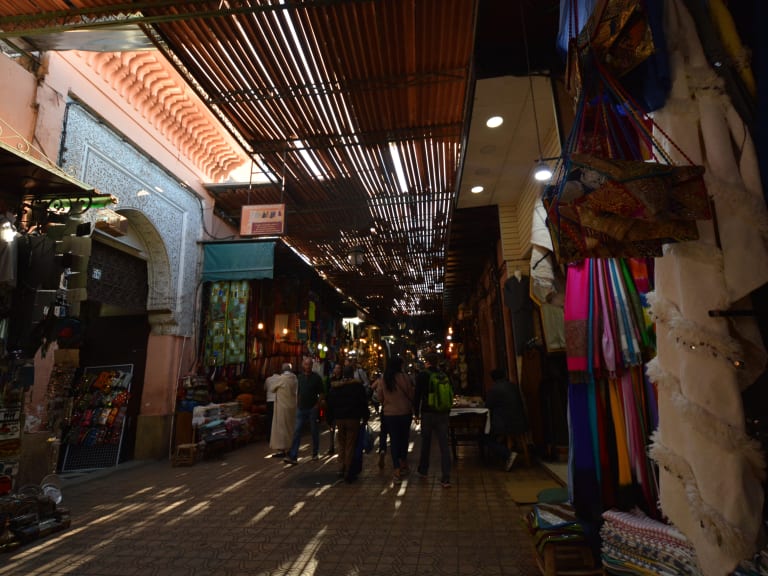
To take advantage of having enough days to visit the city without haste, this first day will be devoted to a contact with its bustling medina, souks and the Jamaa El Fna square. If you prefer, you can do this first route with one of the guided tours offered in Marrakech.
The goal of this day, in addition to seeing a few things, will be to learn how to get around Marrakech and make sure you know the various safety tips on a trip to Morocco.
A leisurely stroll through the Medina and the souk of Marrakech.
The medina or old city is the heart of Marrakech and hides in its walled interior a good part of the attractions that attract any visitor. This area is made up of a maze of narrow streets, mostly very narrow. Thousands of people pass through them at any given moment, mingling with the countless stores that line the way.
This first walk through these streets can impress many tourists or even intimidate them a little. The presence of a guide can alleviate some of this shock, but this contact with the reality of the medina should also serve to know what attractions hides the Medina of Marrakech.
My proposal is to spend a full morning touring both these streets and the souk, the commercial area of the medina and that occupies much of its streets. Here you will be surprised by the great variety of products sold and the insistence of traders to attract potential customers. To take a break from the hustle and bustle, the medina offers a couple of places to relax. The main one is the so-called Jardin Secret (the Secret Garden), a restored former palace with beautiful gardens filled with cafes and stores.
Lunch at the Terrase des Epices
After this first walk through the Medina and the souk it is also worth getting in touch with another of the outstanding facets of the country's culture: gastronomy.
The ideal would be to do one of the tours dedicated to that topic, but if it is not possible it is best to keep an open mind and go tasting the different Moroccan dishes that appear on the menu.
For this first meal I recommend going up to the terrace of Des Epices, where the quality of their products seems to increase thanks to spectacular views of the city.
Ben Youssef Madrasa

After regaining our strength, we will continue our walk through the medina, but this time with a specific destination: the Medersa or Madrasa Ben Youssef. This religious school housed about 900 students in its heyday.
Today you can visit upon payment of an entrance fee. The central courtyard and the delicate decoration of its arches and doors are particularly noteworthy. It is also surprising to see the austerity of the cells in which the students resided.
Very close to this place is the so-called Almoravid Quobba. Crowned by a dome, it is the only example of Almoravid art that remains in the city. Finally, it is worth taking the time to enter and explore the souk that houses the Souk Foudouq Ouarzazi.
Jamaa el Fna Square
After touring the medina it is time to approach the true icon of Marrakech and the whole country: the Jamaa el Fna square.
Although another of the days of the trip will return here to see the daytime atmosphere, it is when evening falls when the square takes on an impressive appearance. It is crowded with fortune tellers, musicians, acrobats, storytellers and a number of places to eat. All this gives it a look reminiscent of the tales of The Thousand and One Nights
Before plunging into the square you can find a place in one of the cafes with terrace that are in the area and watch the sunset from there. After that, I recommend that you join the magical atmosphere that develops in Jamaa el Fnaand dine on some local food at one of the tables that are installed there.
Day 2, 3 and 4: Day trip to Merzouga, the fortress of Ait Ben Haddou and the Dadès Gorge
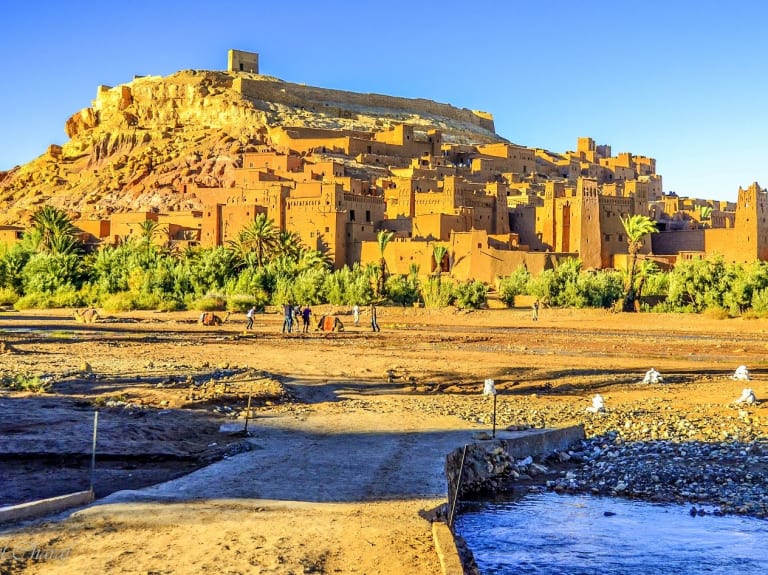
There are a number of excursions organized from Marrakech that will allow you to discover the desert.
Although all options have their charm, this time I have chosen the excursion that lasts three days and covers some interesting places such as Ait Ben Haddou, Ouarzazate and the sand dunes of Dades.
Ait Ben Haddou
One of the most spectacular places to visit in the outskirts of Marrakech is undoubtedly the ksar of Ait Ben Haddou.
Known as the gateway to the desert, the sight of this fortified town located on a cliff takes you back in time to the era when the Berbers built it to make it easily defensible.
A walk through the kasbahs that are in its streets is an experience you will hardly forget. Its spectacular nature and its good preservation have made this place has been chosen as the setting for many films and series, including Game of Thrones.
Ouarzazate and Taourirt Kasbah
Located at the foot of the Atlas Mountains and a few kilometers from the desert, Ouarzazate (Ouarzazate in Spanish) is a must for those passing through the area. The center of the city is the Al Mouahidine square, full of cafes, stores and restaurants.
Moreover, Ouarzazate is known by the nickname of "the Hollywood of Africa" for the presence of several film studios and the number of films that have been shot in them taking advantage of the beauty of the city. If you have time, it is worth visiting the facilities of Atlas Studio to learn about the relationship of this city with the seventh art.
On the outskirts of Ouarzazate is another of the great attractions of the area: the kasbah of Taourirt. It is considered the largest kasbah in the country and, after being restored, perfectly shows all its extraordinary decoration. Around it is the medina, a place where life seems to have stopped.
Dades Valley
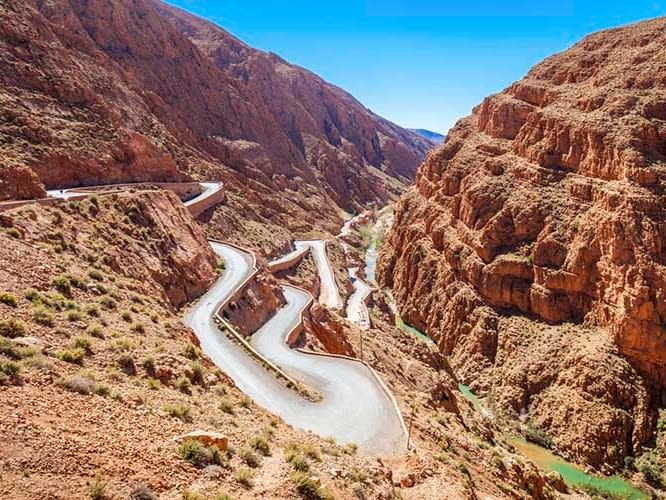
Known as "The route of the thousand kasbahs", to cross this valley is to enter in the middle of nature. The Dades Valley is bathed by the river of the same name that rises in the High Atlas. The whole area is full of impressive canyons and gorges, not forgetting the oasis of Skoura.
In addition, the route may take you through other attractions such as the kasbah of Amridril and the Valley of the Roses.
Despite its location, you will be surprised how the areas where there is water have developed a great ecosystem and that the locals take advantage of it to place orchards, palm groves and other plantations. As soon as the water disappears, everything becomes desert.
Night in Tinerhir
Although the excursions may have some differences, many of them make the first night in the small town of Tinerhir.
Actually, this village has only two main arteries, but walking through them is quite pleasant. Its location as a crossing point for travelers has led to the opening of several terraces where you can sit and relax.
The only place to visit is the old kasbah of Cheikh Bassou, now converted into a luxury hotel, although you can enter to see the original rooms and walls.
Merzouga desert
After breakfast, the tour continues to its most interesting point: the dunes of Erg Chebbi in the desert of Merzouga. Normally, this part of the tour combines the motor vehicle with a camel ride until you reach the camp where you will spend the night. Erg Chebbi is the only really sandy area in that part of the desert and has an extension of 22 kilometers long by 5 wide.
The day ends with a traditional dinner at the camp. You can not miss the sunset in the desert, nor the blanket of stars that will envelop you during the night in the desert of Marrakech.
Upon awakening, you will set off on your way back to Marrakech. On the way back to Marrakech, you can continue to enjoy the unique landscapes, as well as making some interesting stops.
Day 5: the best monuments of Marrakesh in depth
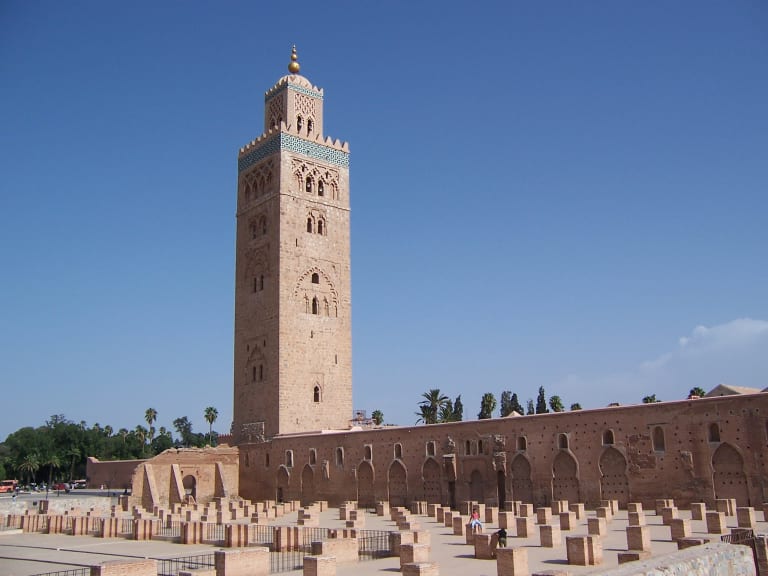
After two nights and three days out of Marrakech, it is time to resume the itinerary through the city. This day we will return to the medina to visit some of its most important monuments.
Koutoubia Mosque
The silhouette of the Koutoubia Mosque can be seen from much of Marrakech. The interior can not be visited as it is intended for worship, but the exterior decoration and its minaret of about 70 meters high make this building a must-see. The whole structure, moreover, is quite reminiscent of the Giralda in Seville.
The mosque was built in the twelfth century on the basis of another mosque that was located there. Because of its name, which means "of the books", it is assumed that in that area there was a large market dedicated to these publications.
This building has a curious legend: once built, the walls of the mosque began to bleed so heavily that the blood stained the streets and houses of Marrakech red. It is for this reason, according to this myth, that the town is known as "the red city".
Saadi Tombs
The next destination is the Saadid Tombs, built by Sultan Al Mansur at the end of the 16th century to bury his mother.
Some decades later, Sultan Mulay Ismail (known as El Sanguinario), ordered the entrances to the tombs to be walled up and they were forgotten until the French rediscovered them in 1917.
Today, the tombs can be accessed through a narrow corridor that leads to a courtyard where dozens of second-tier characters of the Al Mansur court are buried. In addition, in the complex you can visit the mausoleum where the mother of the sultan lies, the Hall of the 12 Columns (where Al Mansur himself was later buried), the prayer hall and the hall of the Three Niches.
El Badi Palace

One of the advantages of having a guide is that he will explain everything you are seeing. Otherwise, you may miss some interesting details. In this case, the first impression when you arrive at the El Badi Palace is that there are only ruins. However, these remains were once the most lavish palace in the world. With 360 rooms, Italian marble, onyx from India, granite brought from Ireland and gold leaf to decorate the walls were used for its construction.
The current visit is limited to the structures of the palace, as well as the beautiful gardens surrounding it, with its orange trees, carob trees and pools. In the subway area you can still see the cells used for prisoners. Likewise, no one should miss the luxurious minbar that hides the prayer room.
After this visit I recommend you take a break for a bite to eat at La table de Marrakech, one of the best mid-priced restaurants in Marrakech. It also has a terrace with truly unbeatable views.
Bahia Palace
This other palace, fortunately in better condition, is considered one of the most interesting buildings in Marrakech.
The Bahia Palace has 150 rooms and multiple courtyards and gardens spread over its 8 hectares of extension. The building was ordered to be built in the 19th century by Sultan Si Moussa, although its owner would be a former slave, Abu Bou Ahmed, who strove to give it the maximum possible splendor.
The most interesting points in the visit are the harem area and the aforementioned courtyards and gardens. Likewise, there are few sights more beautiful than the decoration of its ceilings.
Mellah: the old Jewish quarter
To end the day you can make a visit to the old Jewish quarter of the city, called (as in the rest of the country) Mellah.
This neighborhood was built to receive the Jews expelled from Portugal and Spain in the sixteenth century. There they brought their culture and religion and, today, two of the most interesting places to visit are the Al Azama Synagogue and the Jewish Cemetery...
Apart from these two places, it is worth strolling calmly through its narrow streets trying to find the differences with other parts of the city. The neighborhood also has a large number of stores with cheaper prices than in the souk of the medina.
Day 6: Essaouira
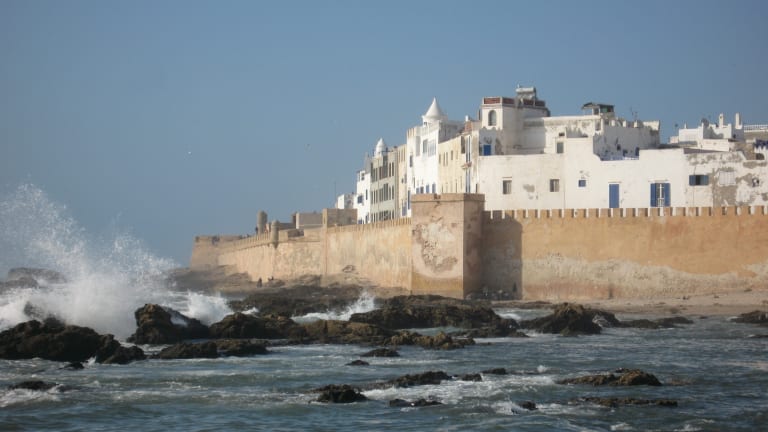
One of the most interesting places to visit in one day from Marrakech is Essaouira. The visit will not leave anyone indifferent, so I recommend hiring an organized tour or even get to Essaouira on your own.
Essaouira
If you want to make the most of this day it is necessary to leave early to travel the 160 kilometers that separate the two cities and reach the destination as soon as possible. Essaouira is a coastal city full of charming places, to the point that its medina was named a World Heritage Site by Unesco. Walking through its streets, much quieter than those of Marrakech, will allow you to discover unique corners and the beauty of each of its ocher-colored houses. Do not forget to take a walk around its port, crowned by a large bronze cannon. In addition, it is also a must to visit the Moulay al Hassan square and its souks.
Another visit of interest is related to one of the products that give wealth to the area, the argan tree, a tree from whose ripe seeds a precious oil is extracted. Thus, it is very interesting to enter one of the cooperatives dedicated to producing this oil and learn about its properties.
Its location by the sea means that its restaurants offer many fish and seafood dishes. Regardless of your choice, I assure you that you will love them.
Enjoy dinner on your return to Marrakech
Most likely, when you return to Marrakech in the evening after your excursion, you will be quite tired. For this reason, it is best to find a good place to dine and relax.
Many riads, if you are staying in one, offer high quality traditional dinners. If you prefer to go out, you can go to the great terrace of the Nomad or the beautifully decorated Le Jardin.
Day 7: Last shopping, lunch in a garden and farewell to the city
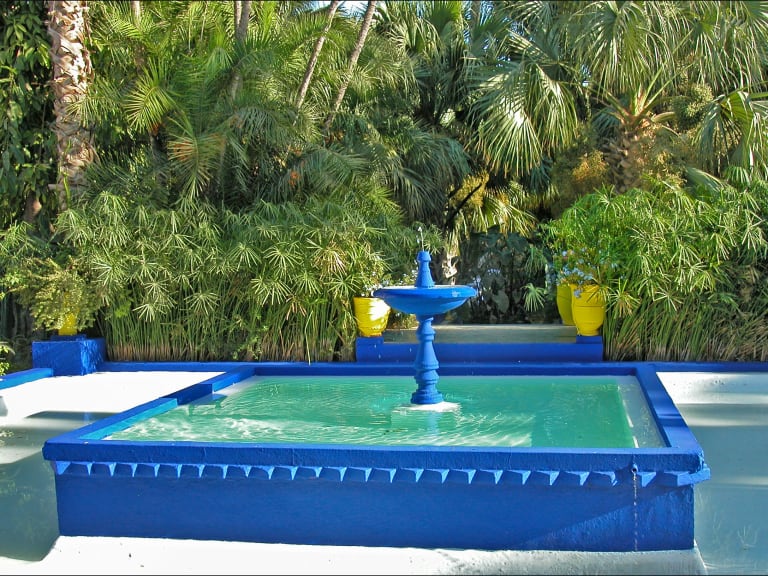
The feelings on the last day of any trip are bittersweet. On the one hand, all the moments lived are still in the memory, but on the other hand it is getting closer and closer the time to go back home.
To say goodbye to the stay in Marrakech I have prepared a not too intense tour, thinking especially of those who have to go to the airport from the center of Marrakech during the day to catch their plane back.
Last purchases in the souk
With all the experience gained during your stay, this is the best time to go back to the souk to buy some gifts or souvenirs. As you will have found, the best way to get around this market is not to get nervous at the insistence of some vendors.
So wander the streets of the souk without setting a pre-determined direction, choosing the parts of the souk where the types of products you are looking for are sold. One of the most colorful areas is Rahba Kedima Square, where you will find all the stores and stalls selling spices and aromatic herbs.
Of course, you must not forget the unwritten rule of these souks: bargain, bargain, bargain until you reach an agreement.
Menara Garden, an ideal place to have a picnic
I am sure that the visit to the souk, no matter how relaxed you have tried to go, will have left more than one exhausted. To recover there is no better place than the Menara Garden, the largest in Marrakech.
In addition to strolling along its paths, I recommend that you imitate the locals and buy some food to take it under an olive tree. Try to find a good spot, as the garden usually receives many visitors, especially in summer in Marrakech and on holidays.
The Majorelle garden
After the picnic it can be very pleasant to take a walk to one of the most peaceful spots in the city: the Majorelle Garden.
This garden was created by a French painter, Jacques Majorelle, who ordered to build an art deco style villa and surround it with cacti, bamboos and other plants. This oasis in the middle of the city also stands out for a kind of intense blue color that the painter himself invented to give more vividness to the space he had designed.
Get to know the modern district of Gueliz
With the evening falling, it's time to visit the modern quarter of Marrakech. This, called Gueliz, was built by the French at the time of the protectorate.
The center of the neighborhood is the 16 November square, from which emerge several large avenues built in the style of Parisian boulevards. The most important is Mohammed V Avenue, where you will find the most modern stores and restaurants of Western type. The most striking thing about this area is that it has a totally different atmosphere than the medina, which is only about 3 kilometers away.
Depending on the time and when your flight departs, this area is perfect both to try some typical sweets and to have some dinner.















